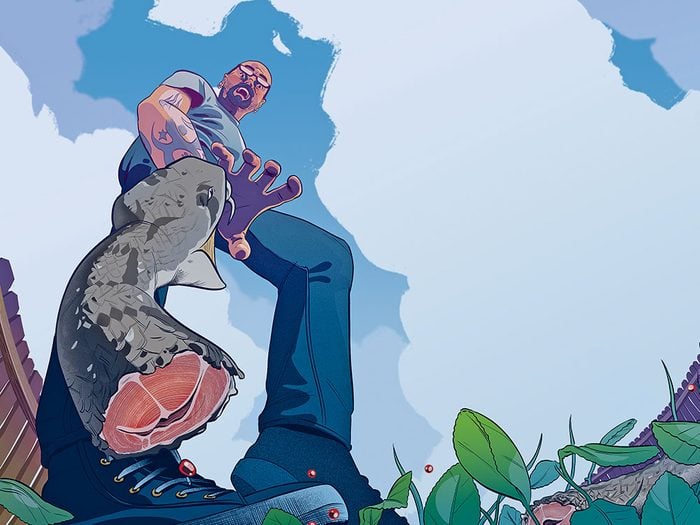This Man Was Bitten By a Rattlesnake—After It Had Been Decapitated!

When Jeremy Sutcliffe decapitated the poisonous snake, he assumed that would be the end of it. He was wrong.
Before the incident—before his body became a battleground for competing poisons and his story the subject of zoological curiosity—Jeremy Sutcliffe had actually liked snakes. He’d found them beautiful, even.
Besides, the tattooed 40-year-old wasn’t someone who shied away from wild creatures. He was an avid outdoorsman who took every chance he could to camp and fish. That love of nature had been part of the reason Sutcliffe and his wife Jennifer, 43, had recently moved to South Texas from Kansas. The place they’d bought on Lake Corpus Christi, a short drive from the Gulf of Mexico, was their dream home. Or that’s what it was going to be. At the moment, they were living in a trailer on their one-acre lot, and the house was still a fixer-upper. A “total gut job,” Sutcliffe called it, with the pride of someone who plans on doing the gutting himself.
On a steamy Sunday morning in May 2018, the couple was tidying their yard in preparation for an evening cookout with their daughter and her two young children. At around 10:30 a.m., Sutcliffe began mowing the lawn while Jennifer worked on the garden. She had just reached down to grab a weed when she saw it: a western diamondback rattlesnake, right next to her hand.
Jennifer leaped up as the snake, a metre long, rose into a striking position, with its dusty triangular head tensed and its tail rattling. “Snake!” yelled Jennifer as she backed away. “Snake!”
The Deadly Blow
When Sutcliffe heard his wife’s cry, he figured she’d run into one of the harmless rat snakes that often showed up on the property. He grabbed a shovel to shoo the creature away and jogged around the house to the garden. That’s when he heard the rattling. His wife was cornered between some shrubbery and the wall of the house, a viper directly in her path.
He first tried to scoop up the snake using the shovel, without success. Then he did what was necessary: he raised the garden tool and brought the edge down hard through the snake’s body just below the head, decapitating the reptile.
Jennifer went into the house, her heart hammering, while Jeremy headed back to the garden. About 10 minutes later, when Jennifer said she was going to let their two small dogs out, he decided to move the dead reptile. He looked at the creature lying limp on the ground. Its head rested on a paving stone, attached to a stub of body.
He bent down to pick up a stick lying next to the snake’s head so that he could flick it away. But before his hand even touched the ground, the snake attacked—a blur of motion as the creature launched itself forward. Burying its fangs into Sutcliffe’s right hand down to the bone, the snake injected venom that immediately made his hand feel like it had been smashed by a massive weight. “It bit me!” he yelled in horror.
For Sutcliffe, it was like something out a zombie movie—an undead creature’s final act of revenge. But the truth is, bites from decapitated snakes aren’t uncommon. “Reptiles can stay alive for quite a long time after sustaining a life-limiting injury,” says Christine Rutter, a veterinary critical-care specialist at Texas A&M University who has seen her share of snakebites. A decapitated snake is like a chicken with its head cut off, only with a much longer survival time because it’s a cold-blooded reptile with a slow metabolism.
In that moment, however, all Sutcliffe was thinking about was that the snake that he’d killed was now trying to kill him. The creature’s jaws were clamped around his hand. Desperate to free himself, Sutcliffe inserted the fingers of his left hand beneath the snake’s upper jaw and tried to pry the fangs free. He managed to remove one of the fangs from his middle finger, but as he tried to pull the head loose, the viper’s jaw clenched again, burying the fang in his ring finger this time.
At the sound of his cry, Jennifer, a trained nurse, had come running. When she saw her husband struggling with the rattlesnake’s head, one thought flashed through her mind: he needed medical attention, now. She ran back into the trailer to get the car keys while Sutcliffe continued to yank at the snake’s head until finally the fangs came loose and he could fling the viper away.
Jennifer told her husband to get in the car. She wheeled out onto the broiling Texas asphalt, already on the phone with 911 dispatchers. They were a half-hour away from the nearest hospital and she had no idea which of the medical centres in the area held anti-venom. All she knew was that they didn’t have much time.
Slipping Away
Jennifer Sutcliffe had always been quick to act under pressure. In Texas, she was a nurse consultant, but back when she’d worked in hospitals she’d always been the go-to person for CPR—someone colleagues would turn to when competence and quick thinking could be the difference between life and death.
She’s known her husband for their entire adult lives. They’d met in the summer of 1993, when they were both students working at a nursing home. She’d liked his sparkling blue eyes and the fact that he was kind. The two became friends, then more.
They were married a couple of years later and went on to have a son and a daughter. Sutcliffe was handy, a builder and a tinkerer who worked installing heating and air conditioning. He always seemed to be helping out one neighbour or another.
In 2011, at the age of 34, Sutcliffe was diagnosed with Guillain-Barré syndrome, a rare and mysterious condition that causes the immune system to attack healthy nerve cells. The disease left Sutcliffe weak and exhausted, unable to work more than a few hours a day, but the couple got through it together. When they bought the house in Corpus Christi, it felt like the ideal situation. While she worked, he would slowly create their dream home.
Now, as Jennifer sped down the highway, she could feel that fantasy slipping away. On the phone, the 911 dispatcher was directing her down the highway to a spot where an ambulance would meet them to bring her husband to the nearest hospital. Mere minutes after being bitten, however, Sutcliffe was already feeling the effects of the venom coursing through his body. When he blinked, there was nothing but blackness. “I can’t see,” he said, panic in his voice, before passing out. Jennifer shook her husband with one hand while keeping the other on the wheel. Sutcliffe woke up, only to pass out again. Then he began having a seizure. The 911 operator told Jennifer to pull over and wait in front of a church for the paramedics.
Finally, after the longest 15 minutes of her life—during which Sutcliffe alternated between babbling incoherently and losing consciousness—the paramedics arrived. They rushed Sutcliffe into the vehicle and took off down the highway with Jennifer speeding behind. After just 10 minutes, however, the ambulance pulled over into the parking lot of an abandoned building. When Jennifer pulled up next to them, they told her that Sutcliffe was in bad shape. His blood pressure had plummeted, and they were worried he wasn’t going to make it to the hospital.
“We have to get the HALO,” one of the paramedics said. Instead of driving to the hospital half an hour away, they were sending for a helicopter that would get him into a different emergency room in 10 minutes. Moments later, the chopper touched down and whisked Sutcliffe away.
The Rattler’s Revenge
Rattlesnake venom is a miracle of evolution—a complex cocktail of enzymes and proteins that, when injected into a victim’s bloodstream, acts like a powerful blood thinner, destroying skin tissue and blood cells and causing internal hemorrhaging. A rattlesnake’s fangs are connected to venom glands at the back of its head. Snakes can control how much venom they inject, and because producing venom takes energy, they typically don’t want to waste it. When cornered, an adult rattlesnake will usually deliver a light defensive strike to scare off a threat.
A snake that has been decapitated, however, has nothing to lose. “Think about it like a Hail Mary pass,” says Christine Rutter. “This snake is pained, he’s scared and he’s going to do everything he can to defend himself.” And so the snake that bit Sutcliffe emptied its venom glands into his hand. The average snakebite victim is given two to four doses of anti-venom. In total, Sutcliffe received 26.
When Jennifer got to the emergency department at Christus Spohn Hospital Corpus Christi–Shoreline, about an hour and 15 minutes after her husband, she found a hectic scene. There were six or seven doctors working on her husband, desperately trying to get his blood pressure up. Just two hours after being bitten, Sutcliffe’s right hand was enormous and swollen, an angry red creeping up his forearm.
She watched with her nurse’s eyes as doctors gave him a host of treatments—cryoprecipitate and vitamin K to clot the blood, and dose after dose of anti-venom. Jennifer knew IVs: if a patient needed fluid quickly, you simply increased the flow, turning a drip into a steady trickle. But the doctors here had put the IV bag into an inflatable sleeve that they’d pumped up like a blood-pressure cuff, literally squeezing fluid into her husband’s body as fast as they could. She’d never seen anything like it before. The sight terrified her.
At 5 p.m., after five hours of working on Sutcliffe, the doctors came to a decision. Sutcliffe’s organs were failing—they needed to induce a coma and put him on a ventilator. Jennifer numbly agreed.
At around 3 a.m., one of the doctors approached her. Her husband wasn’t doing well. His blood pressure was still dangerously low. The mean arterial pressure (or MAP) that doctors were looking for was 65—anything lower and the heart can’t push blood through the body. They had Sutcliffe on the maximum dosage of four medications designed to increase his blood pressure, but his MAP refused to budge above 60. “We’re at the point where there’s nothing else we can do,” the doctor said. There was a good chance Sutcliffe wouldn’t make it through the night.
Jennifer felt her heart plummet. She somehow hadn’t registered the gravity of the situation. She went to her husband’s bedside and grabbed his hand. “You find that venom and you push it out of your body,” she ordered. “You can’t die.”
Over the next half-hour, she stood by her husband’s side in the ICU, her eyes glued to the monitor next to his bed. Slowly, miraculously, she watched as Sutcliffe’s blood pressure ticked up. It made it to 65, then 70. The doctors began taking him off the medications and his pressure remained stable. By sunrise the following day, the worst was over.
A New Perspective
On May 31, five days after the rattlesnake he killed nearly killed him, Jeremy Sutcliffe emerged from his coma and found himself in a strange hospital room. His mind was foggy. His entire body was swollen with more than 20 kilograms worth of water weight. Pain radiated from his legs, his arms, his bowels, everywhere. But as he looked around, he saw that he was surrounded by family: his daughter and her children, his son, Jennifer.
The next weeks were difficult. The mixture of venom and anti-venom had caused severe kidney damage, and Sutcliffe needed dialysis. The toxins had left him with gallstones, kidney stones and fierce abdominal pain. He was so weak he couldn’t stand. The medical expenses piled up—close to $60,000—so the couple started a GoFundMe account to pay for the battery of treatments. The fingers of Sutcliffe’s right hand were badly wounded; the doctors tried skin grafts but were unsuccessful. In the end, they were forced to amputate his ring and middle fingers.
For anyone else, the loss of two fingers would be devastating. But Sutcliffe didn’t see it that way. After getting a glimpse of the worst, he was feeling positive. About a month after the bite, his kidneys were working well enough for doctors to take him off dialysis. “I’d trade a couple of fingers for my kidneys coming back,” he said.
Lying in a hospital bed, slowly recovering, he’d had time to think. “When I first came to and things were all right, I’d cry a lot and think about all the dumb things I’d done, the people I’ve hurt,” says Sutcliffe. He remembered skipping his kids’ events or ignoring Jennifer while he was off working on a neighbour’s house. It wasn’t that he’d done anything so terrible—just that his new perspective suddenly made every misstep seem like a tragic waste. The experience had changed him. “The things that used to matter don’t feel like they matter as much,” says Sutcliffe. “My wife and my family seem so much more important now.”
In late June, he was released from the hospital and the couple moved back to their dream-home-in-progress. And one evening in July, they finally had the cookout they’d been planning. Their daughter and grandchildren came over, as did a neighbour. Everyone sat out in the garden, eating hamburgers, grilled corn and potatoes and enjoying the warm Texas air. The Sutcliffes paused to take it all in. This was their paradise, and no snake could change that.
Check out more Drama in Real Life from the pages of Reader’s Digest Canada.






